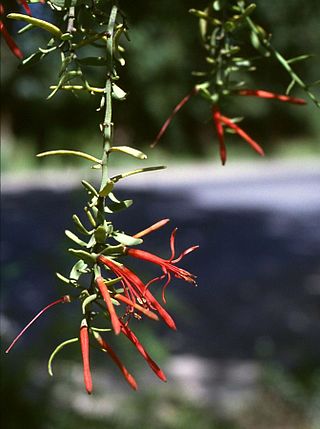
Loranthaceae, commonly known as the showy mistletoes, is a family of flowering plants. It consists of about 75 genera and 1,000 species of woody plants, many of them hemiparasites. The three terrestrial species are Nuytsia floribunda, Atkinsonia ligustrina, and Gaiadendron punctatum Loranthaceae are primarily xylem parasites, but their haustoria may sometimes tap the phloem, while Tristerix aphyllus is almost holoparasitic. For a more complete description of the Australian Loranthaceae, see Flora of Australia online., for the Malesian Loranthaceae see Flora of Malesia.

Nathaniel Lord Britton was an American botanist and taxonomist who co-founded the New York Botanical Garden in the Bronx, New York.

Schoenoplectus is a genus of plants in the sedge family with a cosmopolitan distribution. Note that the name bulrush is also applied to species in the unrelated genus Typha as well as to other sedges. The genus Schoenoplectus was formerly considered part of Scirpus, but recent phylogenetic data shows that they are not closely related.

Scinax is a genus of frogs in the family Hylidae found in eastern and southern Mexico to Argentina and Uruguay, Trinidad and Tobago, and Saint Lucia. These are small to moderate-sized tree frogs, drably colored. Duellman and Wiens resurrected this genus in 1992. The name originates from the Greek word skinos, meaning quick or nimble.

Richard Wettstein was an Austrian botanist. His taxonomic system, the Wettstein system, was one of the earliest based on phyletic principles.

Otto Stapf FRS was an Austrian born botanist and taxonomist, the son of Joseph Stapf, who worked in the Hallstatt salt-mines. He grew up in Hallstatt and later published about the archaeological plant remains from the Late Bronze- and Iron Age mines that had been uncovered by his father.

The flora of Romania comprises around 3,450 species of vascular plants, which represents around 30% of the vascular flora of Europe.

Tapinanthus is a genus of mistletoe in the family Loranthaceae, native to Africa. The name of the genus is derived from the Greek tapeinos meaning "low" or "humble" and anthos meaning flower.
Agelanthus kayseri is a species of hemiparasitic plant in the family Loranthaceae, which is native to Kenya, Tanzania and Somalia.
Agelanthus uhehensis is a species of hemiparasitic plant in the family Loranthaceae, which is native to Tanzania.

Tristerix aphyllus is a holoparasitic plant species of the genus Tristerix in the family Loranthaceae. It is endemic to Chile. T. aphyllus is sometimes called the "cactus mistletoe." It should not be confused with the mistletoe cactus, which is an epiphytic cactus, and not a mistletoe.
Vanwykia is a genus of flowering plants belonging to the family Loranthaceae.
Spragueanella is a genus of flowering plants belonging to the family Loranthaceae.
Erianthemum is a genus of flowering plants belonging to the family Loranthaceae.
Oncocalyx is a genus of flowering plants belonging to the family Loranthaceae.

Plicosepalus is a genus of hemiparasitic flowering plants belonging to the family Loranthaceae.
Englerina is a genus of flowering plants belonging to the family Loranthaceae.
Mappianthus is a genus of flowering plants belonging to the family Icacinaceae.
Oedina is a genus of flowering plants belonging to the family Loranthaceae.









